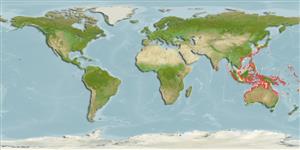Common names from other countries
>
Eupercaria/misc (Various families in series Eupercaria) >
Labridae (Wrasses) > Corinae
Etymology: Hologymnosus: Greek, holos = full + Greek, gymnos = naked (Ref. 45335).
More on authors: Randall & Yamakawa.
Environment: milieu / climate zone / depth range / distribution range
Ecologia
marino associati a barriera corallina; distribuzione batimetrica 15 - 40 m (Ref. 90102). Tropical
Western Pacific: Japan to Indonesia.
Size / Peso / Age
Maturity: Lm ? range ? - ? cm
Max length : 32.0 cm TL maschio/sesso non determinato; (Ref. 9710)
Spine dorsali (totale): 9; Raggi dorsali molli (totale): 12; Spine anali 3; Raggi anali molli: 12
Inhabits seaward reefs, in areas of mixed sand, rubble, and coral (Ref. 9710). Often found in areas with Halimeda algea. May be solitray or form groups. East indian reef fishes of this species are mostly young and rarely larger than 10 cm (Ref. 90102).
Life cycle and mating behavior
Maturità | Riproduzione | Deposizione | Uova | Fecundity | Larve
Oviparous, distinct pairing during breeding (Ref. 205).
Randall, J.E. and T. Yamakawa, 1988. A new species of the labrid fish of the genus Hologymnosus from the Western Pacific, with notes on H. longipes. Rev. Fr. Aquariol. 15(1):25-30. (Ref. 5277)
IUCN Red List Status (Ref. 130435)
CITES (Ref. 128078)
Not Evaluated
Threat to humans
Harmless
Human uses
Informazioni ulteriori
BibliografiaAcquacolturaProfilo di acquacolturaVarietàGeneticaElectrophoresesEreditarietàMalattieElaborazioneMass conversion
CollaboratoriImmaginiStamps, Coins Misc.SuoniCiguateraVelocitàModalità di nuotoArea branchialeOtolithsCervelliVista
Strumenti
Special reports
Download XML
Fonti Internet
Estimates based on models
Preferred temperature (Ref.
115969): 20.6 - 28.8, mean 27.4 (based on 174 cells).
Phylogenetic diversity index (Ref.
82804): PD
50 = 0.5625 [Uniqueness, from 0.5 = low to 2.0 = high].
Bayesian length-weight: a=0.00977 (0.00470 - 0.02030), b=3.07 (2.89 - 3.25), in cm Total Length, based on LWR estimates for this (Sub)family-body shape (Ref.
93245).
Trophic level (Ref.
69278): 3.9 ±0.6 se; based on size and trophs of closest relatives
Resilienza (Ref.
120179): Medio, tempo minimo di raddoppiamento della popolazione 1.4 - 4.4 anni (Preliminary K or Fecundity.).
Fishing Vulnerability (Ref.
59153): Low vulnerability (22 of 100).
